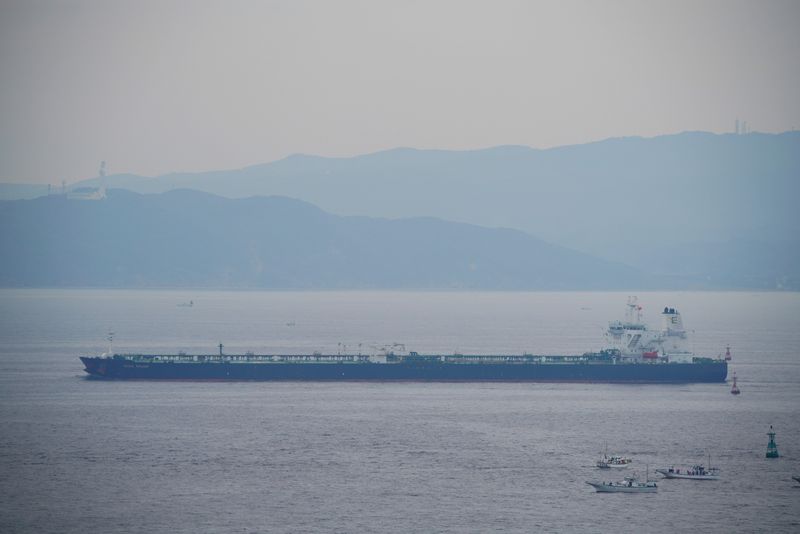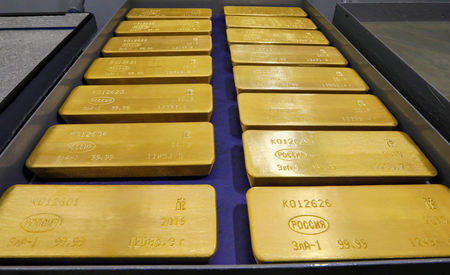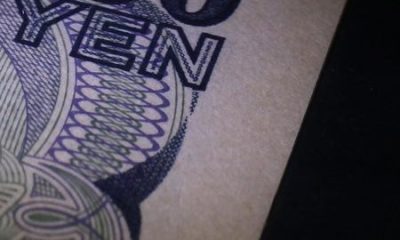Commodities
Iran seizes oil tanker involved in U.S.-Iran dispute in Gulf of Oman


© Reuters. FILE PHOTO: St Nikolas ship X1 oil tanker involved in U.S.-Iran dispute in the Gulf of Oman which state media says was seized is seen in the Tokyo bay, Japan, October 4, 2020, in this handout picture. Daisuke Nimura/Handout via REUTERS
2/2
By Jana Choukeir, Ahmed Elimam and Robert Harvey
DUBAI (Reuters) -Iran seized a tanker with Iraqi crude destined for Turkey on Thursday in retaliation for the confiscation last year of the same vessel and its oil by the U.S., Iranian state media reported, a move likely to stoke regional tensions.
The seizure of the Marshall Islands-flagged St Nikolas coincides with weeks of attacks by Yemen’s Iran-backed Houthi militias targeting Red Sea shipping routes.
“After the theft of Iranian oil by the United States last year, St Nikolas tanker was seized by Iran’s Navy this morning with a judicial order … it is en route to Iranian ports,” the semi-official Fars news agency reported, citing a statement by the Navy.
In Washington, the Pentagon said Iranian forces unlawfully boarded the St Nikolas in the Gulf of Oman and forced it to change course toward Iranian territorial waters.
The White House condemned the seizure.
“No justification whatsoever to seize it, none whatsoever. They need to let it go,” White House national security spokesperson John Kirby (NYSE:) said.
The U.S. seized the St Nikolas last year in a sanctions enforcement operation when it sailed under a different name, Suez Rajan. Iran warned the U.S. the move would “not go unanswered”.
Armed intruders boarded the St Nikolas as it sailed close to the Omani city of Sohar, according to British maritime security firm Ambrey, and its AIS tracking system was turned off as it headed in the direction of the Iranian port of Bandar-e-Jask.
“Communication with the oil tanker, St Nikolas, under Marshall Islands flag and owned by the Greek shipowner Empire Navigation has been cut off around 06:30 on Jan. 11 in the waters of Oman,” Turkish oil refiner Tupras told Reuters in an emailed statement, confirming it had bought the cargo from Iraqi state marketer SOMO.
“The incident has no impact on our refinery operations,” the Turkish firm – which operates the 241,500 barrel per day (bpd) capacity Izmir refinery in Aliaga – added.
The ship loaded around 145,000 metric tonnes of oil in the Iraqi port of Basra and was heading to Aliaga in western Turkey via the Suez Canal, Empire Navigation told Reuters. It said it had lost contact with the vessel, manned by a crew of 19 including 18 Filipino nationals and one Greek national.
Since October, Yemen’s Houthis have attacked commercial vessels in the Red Sea to show support for Palestinian militant group Hamas in its fight against Israel. Those incidents have been concentrated on the Bab al-Mandab Strait, to the southwest of the Arabian Peninsula.
Thursday’s incident is located closer to the Strait of Hormuz, between Oman and Iran.
The United Kingdom Maritime Trade Operations (UKMTO) authority said earlier on Thursday it had received a report that a vessel around 50 nautical miles east of Oman’s coast was boarded by four to five armed persons.
The intruders reportedly were wearing military-style black uniforms and black masks.
The UK authority, which provides maritime security information, said it was unable to make further contact with the vessel and authorities were still investigating.
“Iran’s actions are contrary to international law and threaten maritime security and stability,” U.S. Navy’s Fifth Fleet Commander Vice Admiral Brad Cooper said in a statement.
The Suez Rajan was carrying more than 980,000 barrels of Iranian last year when it was seized and the oil confiscated in the U.S. sanctions enforcement operation.
The U.S. said at the time that Iran’s Islamic Revolutionary Guard Corps (IRGC) had been trying to send contraband Iranian oil to China, in violation of U.S. sanctions.
The vessel was unable to unload the Iranian crude for nearly 2-1/2 months over fears of secondary sanctions on vessels used to unload it. It was renamed the St Nikolas after unloading the cargoes.
Commodities
Oil prices set for steep weekly losses; payrolls could drive sentiment

Investing.com– Oil prices edged higher Friday, lifting from near seven-week lows, but were headed for steep losses this week as signs of robust U.S. stockpiles and production dashed hopes for tight crude markets in the coming months.
At 08:05 ET (12:05 GMT), rose 0.6% to $84.20 a barrel, while gained 0.6% to $79.44 a barrel.
Crude set for hefty losses this week
Despite these gains, both contracts were still trading close to their weakest levels in seven weeks, and were set to lose between 5% and 6% this week.
An unexpected build in U.S. and data showing increased U.S. production suggested that oil markets were not as tight as traders were initially hoping.
This was coupled with easing fears of supply disruptions in the Middle East, as Israel and Hamas continued negotiations over a potential ceasefire.
Concerns over slowing economic growth – which could eat into demand – also came into play this week, especially after the U.S. Federal Reserve warned that it will keep interest rates higher for longer.
Middling data from top crude importer China also factored into fears of sluggish demand. Business activity in the country was seen slowing in April after a strong start to the year.
Markets were also on edge ahead of the release of key U.S. data later in the day, which is likely to factor into the outlook for interest rates.
“The US jobs report which will be released later today, has the potential to be a key driver for oil prices in the immediate term,” analysts at ING said, in a note.
remove ads
.
OPEC+ could extend production cuts
Still, crude found some relief on Friday from a softer , as the greenback retreated in anticipation of the nonfarm payrolls data.
Also helping the tone was a report from Reuters that the Organization of Petroleum Exporting Countries and allies, a group known as OPEC+, could potentially maintain their current run of 2.2 million barrels per day of production cuts beyond the end-June deadline, especially if demand does not pick up.
But cartel members are yet to begin formal talks over the matter. Still, extended production cuts by the cartel could herald tighter markets later in 2024.
Adnoc, the UAE’s national oil company, has increased its production capacity by 200,000 barrels per day to 4.85 million b/d, leaving the producer with a spare capacity above 1.7m b/d, after producing a little over 3.1m b/d in April.
“This could see the UAE push for a higher baseline when OPEC+ discusses its output policy for the second half of 2024,” ING added.
(Ambar Warrick contributed to this article.)
Commodities
Goldman sees potential for gold prices surging above $3000 amid geopolitical risks

2024 has seen gold prices surge to new record levels, with the yellow metal exceeding $2,400 an ounce last month due to increased global demand amid economic and geopolitical uncertainties.
Remarkably, strategists at Goldman Sachs believe there’s even more upside room for the safe-haven metal, saying it could potentially exceed $3,000 by year’s end.
Gold prices rally on geopolitical unrest, central bank demand
One of the primary drivers of this price rally is the strong demand for gold from global central banks and Asian households.
In China, economic recovery challenges post-pandemic and a depreciating yuan, which has lost about 5% against the US dollar over the past year, make gold even more costly for local consumers.
Despite this, both Chinese consumers and the People’s Bank of China (PBOC) continue to pursue gold avidly.
The PBOC has increased its gold reserves for 17 consecutive months, with a 16% rise in its gold holdings during this period, as reported by the World Gold Council. In March alone, the PBOC added 160,000 ounces of gold to its reserves.
Similarly, countries like Turkey, India, Kazakhstan, and some in Eastern Europe have been active gold buyers this year.
This accumulation reflects a broader trend among global central banks to diversify their reserves and lessen their dependence on the US dollar.
Gold prices witnessed a proper pullback at the end of April, but the bullish sentiment returned this week after Federal Reserve policymakers hinted that rate cuts could be on the horizon.
At its latest policy meeting on Wednesday, the Fed maintained its interest rate stance, as widely anticipated. The policy statement continued to echo previous economic assessments and guidance, suggesting conditions that could lead to a reduction in borrowing costs.
remove ads
.
Fed Chair Jerome Powell stated that any future rate decisions would be data-driven, but he noted that a rate hike was unlikely at this point.
This reassurance from Powell, effectively ruling out further rate hikes, contributed to gold prices staying above $2,300. Lower interest rates further increase gold’s appeal as they typically reduce yields on fixed-income assets like bonds.
Meanwhile, geopolitical tensions, particularly in the Middle East, have also boosted investor interest in the bullion. Gold is considered one of the oldest safe-haven assets, witnessing strong demand during times of geopolitical unrest and wars.
Goldman Sachs says gold prices may exceed $3000
Citing robust demand for gold from emerging market (EM) central banks and Asian households, strategists at Goldman Sachs maintained their base case projection that the precious metal will rise to $2,700 per troy ounce by the end of the year, reflecting a 17% increase.
Using their model, which incorporates previous estimates of gold supply and demand elasticity, Goldman strategists also see potential for even higher gold prices under certain conditions.
Specifically, they predict that if US financial sanctions intensify at a pace similar to that since 2021, gold prices could climb an additional 16% to $3,130 per troy ounce “on the back of additional central bank buying of 7Mtoz annually,” they wrote.
“Such an increase in our US financial sanctions index would be akin to the hypothetical addition of roughly two or more US financial sanctions on China or six financial sanctions on India,” strategists said.
In a second scenario, Goldman estimates that if the US 5-year Credit Default Swap (CDS) spread widens by one standard deviation (13 basis points), gold prices could increase by an additional 14%, reaching $3,080 per troy ounce, driven by central banks purchasing an additional 6 million troy ounces of gold annually.
remove ads
.
“To be clear, the geopolitical, fiscal, and financial outlooks, and their exact impact on central bank gold demand and gold prices are all highly uncertain. That said, our exercise underscores the hedging value of gold against adverse geopolitical or financial scenarios, in which equity-bond portfolios would likely suffer,” strategists added.
Commodities
Oil prices set for steepest weekly drop in 3 months

By Ahmad Ghaddar and Deep Kaushik Vakil
LONDON (Reuters) -Oil prices edged higher on Friday yet remained on course for their steepest weekly loss in three months weighed by concerns about demand and high interest rates.
futures for July rose 43 cents, or 0.5%, to $84.10 a barrel by 1200 GMT. U.S. West Texas Intermediate crude for June was up 34 cents, or 0.4%, to $79.29 per barrel.
Both benchmarks are set for weekly losses as investors are concerned higher-for-longer interest rates will curb economic growth in the U.S., the world’s leading oil consumer, as well as in other parts of the world.
Brent was on course for a weekly decline of about 6%, and WTI for a loss of 5.4% on the week.
“We view the commodities sell-off over the last two days as collateral damage from the Fed repricing and non-fundamental in nature,” JP Morgan analysts wrote in a note.
The U.S. Federal Reserve held interest rates steady this week, and flagged high inflation readings that could delay rate cuts.
The market awaits monthly data due on Friday about U.S. nonfarm payrolls, a measure of labour market strength that the Fed takes into consideration when setting interest rates.
Higher rates typically weigh on the economy and can reduce oil demand.
Also on Friday, energy services firm Baker Hughes is due to release its weekly count of oil and gas rigs, an indicator of future crude output from the world’s top producer. [RIG/U]
Geopolitical risk premiums due to the Israel-Hamas war, which has the potential to lead to oil supply disruption, have also faded as Israel and Hamas consider a temporary ceasefire and hold talks with international mediators.
remove ads
.
“Hopes of a ceasefire and a sharp rise in {{8849|U.S. crcrude oil inventories have caused the price of a barrel of Brent crude to slip below $85,” said Commerzbank (ETR:) analyst Barbara Lambrecht.
Further ahead, the next meeting of OPEC+ oil producers – members of the Organization of the Petroleum Exporting Countries and allies including Russia – is set for June 1.
Three sources from the OPEC+ group said it could extend its voluntary oil output cuts of 2.2 million barrels per day beyond June if oil demand does not increase.
JP Morgan, which expects OPEC+ to extend cuts beyond June, said that a counter-seasonal rise in oil inventories last month would be a concern for the producer group.
“The stock builds in April will turn into draws in May through August and can push prices into the $90s in September,” the bank said.

 Forex2 years ago
Forex2 years agoForex Today: the dollar is gaining strength amid gloomy sentiment at the start of the Fed’s week

 Forex2 years ago
Forex2 years agoHow is the Australian dollar doing today?

 Forex1 year ago
Forex1 year agoUnbiased review of Pocket Option broker

 Forex2 years ago
Forex2 years agoDollar to pound sterling exchange rate today: Pound plummeted to its lowest since 1985

 Cryptocurrency2 years ago
Cryptocurrency2 years agoWhat happened in the crypto market – current events today

 World2 years ago
World2 years agoWhy are modern video games an art form?

 Stock Markets2 years ago
Stock Markets2 years agoMorgan Stanley: bear market rally to continue

 Economy2 years ago
Economy2 years agoCrude oil tankers double in price due to EU anti-Russian sanctions

































